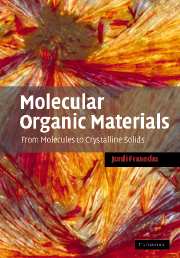Book contents
- Frontmatter
- Contents
- Preface
- List of abbreviations and symbols
- List of chemical abbreviations
- 1 An introduction to molecular organic materials
- 2 Building molecules: molecular engineering
- 3 Building materials: crystal engineering
- 4 Interfaces
- 5 Thin-film growth: from 2D to 3D character
- 6 A miscellany of physical properties
- Afterword
- Appendix A
- Appendix B
- References
- Index
Appendix A
Published online by Cambridge University Press: 23 November 2009
- Frontmatter
- Contents
- Preface
- List of abbreviations and symbols
- List of chemical abbreviations
- 1 An introduction to molecular organic materials
- 2 Building molecules: molecular engineering
- 3 Building materials: crystal engineering
- 4 Interfaces
- 5 Thin-film growth: from 2D to 3D character
- 6 A miscellany of physical properties
- Afterword
- Appendix A
- Appendix B
- References
- Index
Summary
Table A.1 shows the symmetry operations of the point groups more commonly used in the book. The notation for the symmetry operations is the following:
E identity transformation
Cn proper rotation of 2π/n radians (n ∈ ℕ): the axis for which n is greatest is termed the principal axis
Sn improper rotation of 2π/n radians (n ∈ ℕ): improper rotations are regular rotations followed by a reflection in the plane perpendicular to the axis of rotation
i inversion operator (equivalent to S2)
σ mirror plane
σh horizontal reflection plane: perpendicular to the principal rotation axis
σv vertical reflection plane: contains the principal rotation axis
σd diagonal or dihedral reflection plane: bisects two C2 axes
- Type
- Chapter
- Information
- Molecular Organic MaterialsFrom Molecules to Crystalline Solids, pp. 309Publisher: Cambridge University PressPrint publication year: 2006

